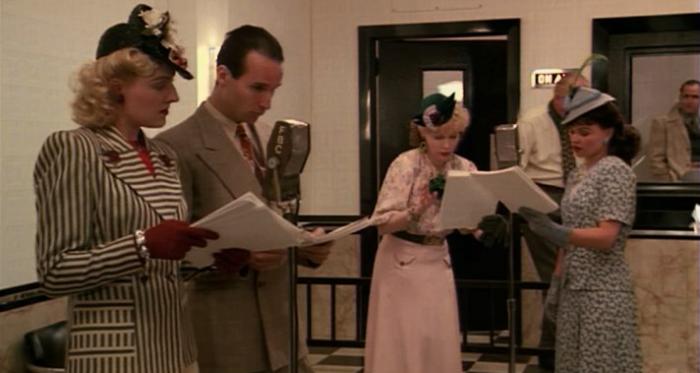The most common movie structure relies on plot: something significant happens to our protagonist which sets them on a course toward resolution. To take E. M. Forster’s famous example of plot: The King died, the Queen died of grief. But what if you don’t want to tell a single story? One solution is to give a series of vignettes. Although challenging, the vignette structure can work particularly well when it comes to capturing memories of a time and place. Two masterful examples are Federico Fellini’s Amarcord and Woody Allen’s Radio Days. Both movies are warmly nostalgic looks at the filmmakers’ formative years: Fellini’s as a teenager growing up in a seaside Italian town in the 30s; and Allen’s as a 12 year-old in a working-class Queens neighborhood during WWII. I’m going to focus on Radio Days in this post because it’s fresh in my mind.

For a while I’ve been interested in taking apart this type of structure. How can you structure a cohesive movie out of what is basically a handful of loose anecdotes? What makes it work? One solution is to rely on voice-over narration, as Allen does throughout. Allen kicks it off like this: “Once upon a time, many years ago… two burglars broke into our neighbor’s house in Rockaway. Mr. and Mrs. Needleman had gone to a movie… and the following events occurred.” As the burglars ransack the Needleman home the phone rings. The rattled burglar answers it: It’s a Name that Tune radio contest. The burglars are so excited they get swept along and win the grand prize. Later that night, the Needlemans come home to an empty apartment. Much to their befuddlement, the very next day they get a surprise furniture delivery — thanks to the burglars! It’s a funny, unexpected way to start the movie.
From then on, Allen pretty much tells us what the structure will be: “Now, I love old radio stories. And I know a million of ’em. I’ve collected ’em down through the years, like a hobby. Anecdotes and gossip… and inside stories about the stars. Plus, I recall so many personal experiences… from when I grew up and listened to one show after another.”
Voice-over can be a lazy filmmaker’s crutch. But Allen just uses it as a framing device for each sequence and as a way to transition to the next anecdote.
The movie works because Allen didn’t just rely on voice-over. As the movie’s producer, Robert Greenhut, explains:
It’s not like most movies, where there’s a discernible spine–a single plot line that you can hang scenes on and, frankly, get away with less planning, because you know that, for example, the suspense can carry you through a rough patch. Here every minute had to count because he was telling so many stories. I think he is always trying to frighten himself, and that’s part of his greatness.”
“Every minute had to count.” Every single vignette had to be great. And by great I mean that each vignette has to elicit an emotional reaction from the audience: make us laugh, cry or wonder. Allen’s original inspiration served as an organizing principle: he wanted to capture how certain songs of the period reminded him of people and events, filtered through the lens of a young boy’s innocence. At heart, Allen was making a group portrait, really, of the family members, places and radio personalities he remembered fondly. The inspiration is exemplified in a sequence in which he recounts each family member’s favorite radio show. It culminates in his cousin Ruthie lip-synching her favorite song:
Allen juxtaposes stories about the glamorous radio personalities his folks followed with the every-day reality of a bustling working-class family in the late 30s and 40s. And the actors Allen chose to play his family are suitably unglamorous. They look like real people as opposed to prettified versions — even the lady the young boys catch dancing naked to Desi Arnaz singing Babalú isn’t conventionally pretty. Their homeliness adds tremendous poignancy to the movie, even if Allen intentionally wrote them as cartoons, which I guess is how a young boy may have perceived them.
I know Woody Allen is a controversial figure. I think a lot of his movies are problematic, particularly when it comes to women. However, my intent here is to analyze scripts and movies. What makes them work and how can I learn from them? I still love Radio Days and consider it a wonderful example of emotional storytelling via vignettes.
